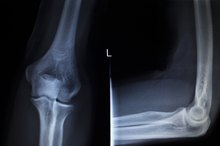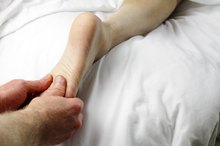What does fact checked mean?
At Healthfully, we strive to deliver objective content that is accurate and up-to-date. Our team periodically reviews articles in order to ensure content quality. The sources cited below consist of evidence from peer-reviewed journals, prominent medical organizations, academic associations, and government data.
The information contained on this site is for informational purposes only, and should not be used as a substitute for the advice of a professional health care provider. Please check with the appropriate physician regarding health questions and concerns. Although we strive to deliver accurate and up-to-date information, no guarantee to that effect is made.
Ligament Tear & Knee Hyperextension
A ligament tear as the result of hyperextending your knee can vary from partial to severe. Symptoms can be severe and interfere with future exercise, sports and even regular daily activities. Because of this, it is important to understand how hyperextension ligament tears of the knee can occur and how they are medically treated.
If you are experiencing serious medical symptoms, seek emergency treatment immediately.
Symptoms
A variety of symptoms can accompany a ligament tear as the result of a hyperextended knee. You can experience pain on the inside of the knee, tenderness, bruising, inflammation, swelling along the joint, stiffness, limited range of motion and instability when trying to stand or walk. You may experience a tearing, pulling or popping sensation when the knee first becomes hyperextended.
Causes
Can Swimming Inflame Tennis Elbow?
Learn More
You can hyperextend your knee if you place excessive force on the joint when it is in a straight position and it bends backward. This can occur in a fall, from a physical blow or during sports such as volleyball, gymnastics or basketball. Hyperextending the knee can tear the ligaments -- frequently the anterior cruciate ligament, or ACL -- that support the knee, causing it to become dislocated from the bones and muscles that adjoin it.
Remedies
Place ice against your knee for 20 minutes at a time every two to three hours for the first 72 hours following the injury to help ease inflammation and knee pain. Wear a knee brace to help immobilize the torn ligament and keep it from further tearing. Rest your knees and walk with crutches if you need to walk around. Elevate your knee above your heart while your ligament injury heals. Severe ligament tears can be surgically repaired by a physician. You may need physical therapy to help rebuild strength in your knee.
- Place ice against your knee for 20 minutes at a time every two to three hours for the first 72 hours following the injury to help ease inflammation and knee pain.
- Wear a knee brace to help immobilize the torn ligament and keep it from further tearing.
Considerations
How to Walk on a Torn Miniscus
Learn More
Do not ignore pain or injury after hyperextending your knee 1. Contact a doctor if you suspect a torn ligament. Multiple ligament tears in the knee can damage the nerves that supply blood to the muscles of your leg. If severe enough, this disruption in blood flow can lead to serious complications such as leg amputation. If surgery is needed to repair the ligament tear, you must wait approximately six months before returning to sports and exercise.
- Do not ignore pain or injury after hyperextending your knee 1.
- If surgery is needed to repair the ligament tear, you must wait approximately six months before returning to sports and exercise.
Related Articles
References
- Mayo Clinic; Hyperextended Knee: Cause of Serious Injury?; Edward R. Laskowski; March 16, 2010
- American Academy of Orthopaedic Surgeons; Combined Knee Ligament Injuries; August 2007
- Spindler KP, Wright RW. Anterior cruciate ligament tear. N Engl J Med. 2008;359(20):2135-42. doi:10.1056/NEJMcp0804745
- Andrews K, Lu A, Mckean L, Ebraheim N. Review: Medial collateral ligament injuries. J Orthop. 2017;14(4):550-554. doi:10.1016/j.jor.2017.07.017
- Kiapour AM, Murray MM. Basic science of anterior cruciate ligament injury and repair. Bone Joint Res. 2014;3(2):20-31. doi:10.1302/2046-3758.32.2000241
- Encinas-ullán CA, Rodríguez-merchán EC. Isolated medial collateral ligament tears: An update on management. EFORT Open Rev. 2018;3(7):398-407. doi:10.1302/2058-5241.3.170035
- Vaquero-picado A, Rodríguez-merchán EC. Isolated posterior cruciate ligament tears: an update of management. EFORT Open Rev. 2017;2(4):89-96. doi:10.1302/2058-5241.2.160009
- DʼLima DD1, Colwell CW. "Intraoperative Measurements and Tools to Assess Stability" J Am Acad Orthop Surg. 2017 Feb;25 Suppl 1:S29-S32.
Writer Bio
Rose Erickson has been a professional writer since 2010. She specializes in fitness, parenting, beauty, health, nutrition and saving money, and writes for several online publications including The Krazy Coupon Lady. She is also a novelist and a mother of three.








